350 million is just the starting point: what wealth passwords are hidden in Arbitrum's RWA ecosystem?
Written by: Castle Labs
Compiled by Saoirse, Foresight News
Abstract
For many, whether or not it can break into the real-world asset (RWA) space has become a benchmark for measuring whether cryptocurrencies achieve mainstream adoption: only if we can connect the on-chain world with traditional finance, Only cryptocurrencies can truly establish themselves as attractive mainstream assets.
The idea is gradually becoming a reality, and U.S. Treasury bonds, bonds and even real estate have been tokenized and put on the chain.
Driven by regulatory clarity and technological maturity, RWA is gaining significant momentum.
This article focuses on the Arbitrum ecosystem, a Layer2 solution that has successfully launched several RWA-focused projects, with the total lock-up value (TVL) of RWA assets currently exceeding $350 million.
This article will provide an overview of RWAs on Arbitrum, the projects and initiatives driving their development, key assets and providers (including case studies), as well as related risk considerations and future prospects.
Overview of RWA on Arbitrum
TheRWA market is booming. Many early crypto adopters fantasized about the use of cryptocurrencies by Wall Street's elites. Today, this vision has been realized, and real-world assets have finally been successfully on-chain and are beginning to be widely adopted.
<img src="https://upload.techflowpost.com/upload/images/20250815/2025081517065399854799.jpg"
> Source: rwa.xyz
Currently, the total value of RWAs exceeds $25 billion, which is distributed as follows:
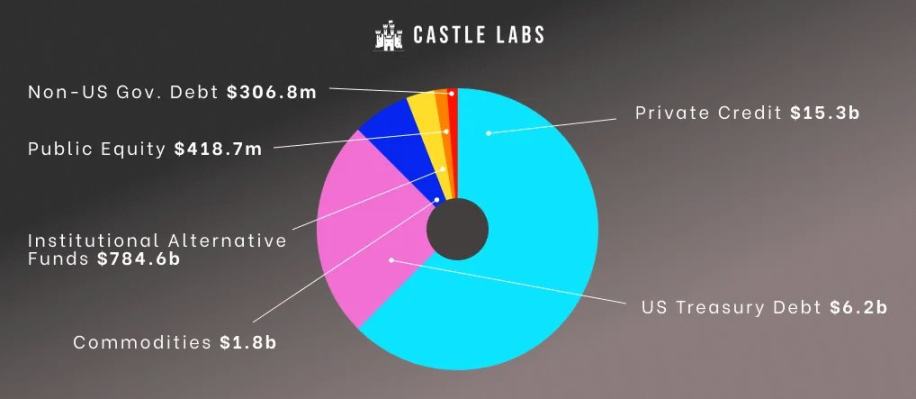
Source: rwa.xyz
-
Private credit: $15.3 billion (60%)
-
U.S. Treasuries: $6.2 billion (26.9
%) -
Commodities: $1.8 billion (7.2%)
-
Institutional alternative funds: $784 million (3.26
%) -
Private equity: $418.7 million (1.71%)
-
Non-US government bonds: $306 million (about 1.2%)
RWA's on-chain is due to a combination of factors:
-
the maturing regulatory framework for digital assets
The -
technical infrastructure has reached production-grade reliability
-
Institutional interest is rapidly heating up
Cryptocurrencies are gradually being accepted and incorporated into regulatory systems, such as MiCA in Europe and the recently passed GENIUS Act in the United States, which means that such assets are gradually being legalized in the broader financial environment.
At the same time, networks such as Bitcoin and Ethereum have been operating stably for more than ten years, fully demonstrating their security, activity, and decentralization characteristics.
However, due to their own characteristics, RWAs require higher protection before they can be put on the chain. Therefore, the emergence of L2s is extremely attractive to institutional investors, as they can significantly reduce on-chain operating costs by several orders of magnitude compared to the Ethereum mainnet.
Among the many layer-2 networks, Arbitrum is one of the fastest-growing layer-2 solutions in the RWA space.
Why Arbitrum?
-
Mature and reliable technology stack
-
Trusted block space neutrality
Arbitrum -
, one of the largest and leading pools in the cryptocurrency space
, has a solid technology stack: its focus on technology-driven development, the launch of technological achievements such as Stylus and Timeboost, making it an effective alternative to the Ethereum mainnet.
Additionally, Arbitrum's backend technology is being used by projects like Hyperliquidx as a cross-chain bridge for USDC, which goes beyond the functionality of its ecosystem itself. This is a testament to Arbitrum's credible neutrality as a block space. Trusted neutrality refers to the principle of fair operation of blockchain networks, treating all participants equally without favoritism towards any user, application, or outcome.
The importance of trusted neutrality:
-
Trust: Users and institutions prefer to rely on a platform that does not arbitrarily change rules or favor one side.
-
Security: A neutral system is more resistant to the risk of manipulation or centralization.
-
Composability: DeFi thrives when developers are confident that no protocol will receive special treatment.
-
Institutional confidence: For RWAs, neutral performance ensures that tokenized assets are not exposed to hidden risks (e.g., censorship, biased governance, etc.).
Finally, it is worth mentioning that Arbitrum has the sixth-largest funding pool in the space, with assets exceeding $1.17 billion, while also having one of the most mature stablecoin ecosystems.
With the ability to represent tangible assets and interest-bearing instruments while combining the programmability and transparency of blockchain systems, RWAs offer new opportunities for institutional investors and decentralized autonomous organizations (DAOs) to diversify investments, stabilize yields, and improve capital efficiency.
What proposals are driving this development?
This section briefly reviews the development of RWAs within Arbitrum. The initial development of RWAs in Arbitrum is driven by the Foundation and the Arbitrum DAO.
Arbitrum DAO's first efforts in the RWA field began with the "Stable Treasury Endowment Proposal" (STEP), followed by the launch of the RWA Innovation Funding Proposal, the Treasury Management Proposal, and finally STEP 2.
STEP (April 2024)
The proposal plans to invest over $85 million (35 million ARB) in real-world assets such as tokenized U.S. Treasuries through institutional issuers.
Although the program was initially a pilot program, after an in-depth analysis of applicants, several providers were successfully screened out:
-
Securitize's BUIDL
-
Ondo Finance's USDY
-
Superstate's USTB
-
Mountain Protocol's USDM
-
OpenEden's TBill
-
Backed's bIB01
screening criteria for applicants are as follows:
-
No investment restrictions
-
Enterprises with a clear organizational structure and no divisions in various departments
-
Substantial asset management, multiple International Securities Identifier (ISIN) exposures, and experienced team
-
Use public or decentralized tools and networks (rather than relying solely on proprietary ones and networks)
-
Avoid choosing companies with additional layers of decentralized governance
-
Adequate and detailed documentation
Additionally, to ensure coverage beyond the above list, STEP also plans to invest 1% of the DAO treasury annually in tokenized real-world assets over the next five years. At the same time, the program also provides a hands-on opportunity to gain a deeper understanding of the RWA space and balance the relationship between ecosystem development and principal protection. Future iterations are expected to focus on one of these goals.
The STEP program has been a huge success, generating $600,000 in interest income for the Arbitrum DAO in less than a year.
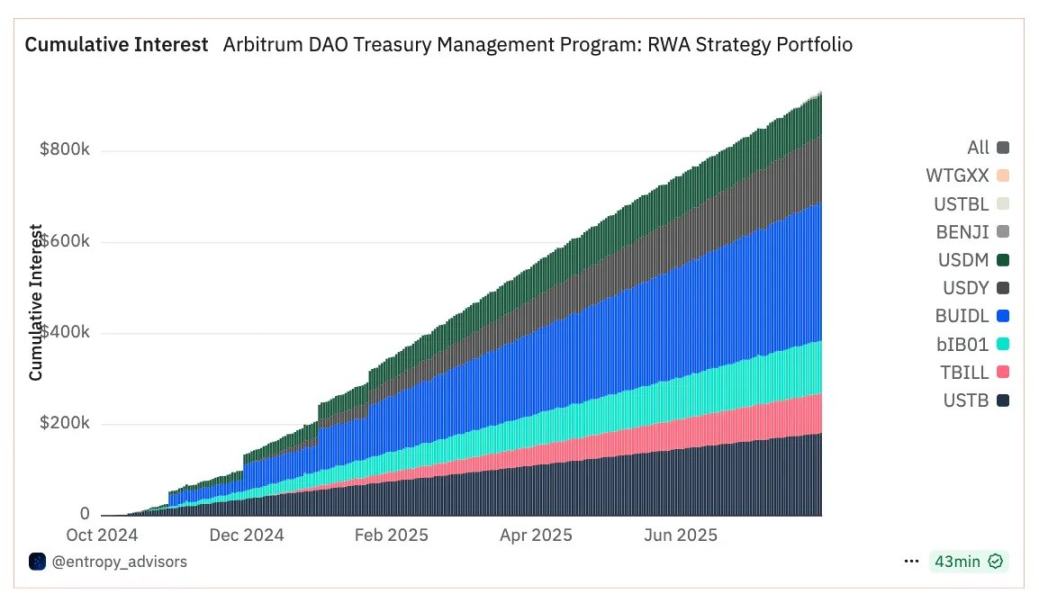
The following is the cumulative amount by month:
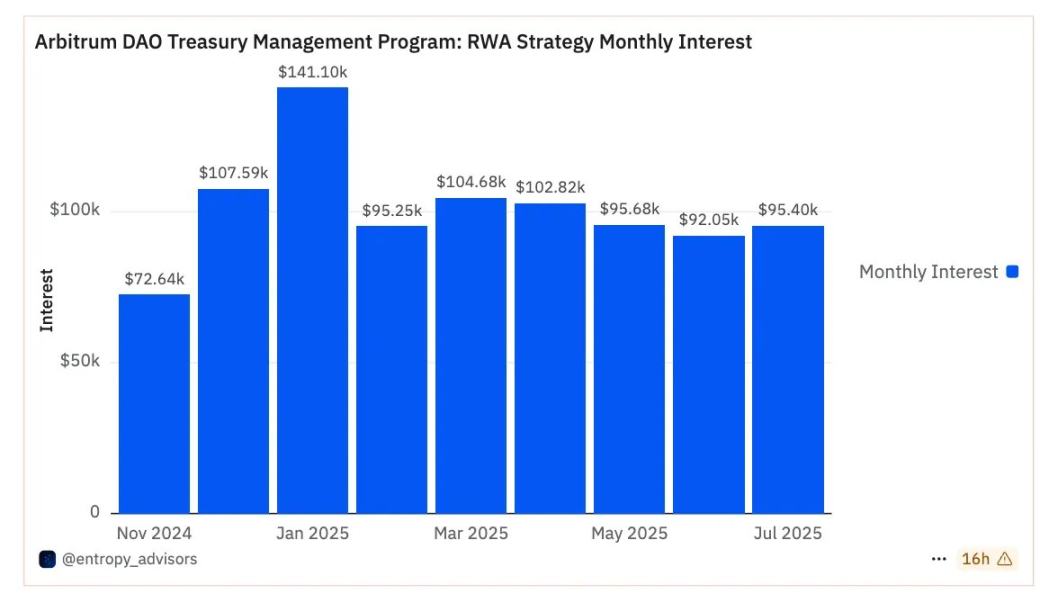
STEP is unique in that it works with institutional service providers based on a clear principle:
-
directly evaluate and screen interest-bearing stable assets without the involvement of intermediaries
-
Using a Request for Proposal (RFP) model, protocols can submit product applications and be reviewed
-
by institutional participants directly in the decentralized forum, which aims to generate sustainable income for DAOs
the RWAIG Grant Program (June 2024).
The Arbitrum Foundation has funded a series of Innovation Grants (RWAIG), a two-month pilot program conducted from June to August 2024 to support RWA integration, analysis, and research efforts within Arbitrum, with a budget of 300,000 ARB.
The main goals of these funding projects are:
-
Significantly increase the activity of RWAs on Arbitrum, stay ahead of the competition, and achieve "platform future growth guarantee
" -
Explore how to invest DAO treasury funds in RWA and how to initiate on-chain tokenization on Arbitrum
-
Wider integration of RWA assets and tools in existing ecological applications such as GMX, Aave, and Pendle
The program ultimately funded 8 different projects:
-
RWA Research: Educating users about the field
-
PYOR: RWA analytics dashboard
-
Mystic Finance: Allowing users to use their knowledge in the field Lending market for RWA asset-backed borrowing stablecoins
-
Jia: Transforming SME receivables into tokenized assets
-
Truflation: Providing real-time inflation data
-
Backed Finance: Creating structured products that track securities
-
Infinfty: Development of ERC-6651 RWA tokens for full-lifecycle treasury management to track product procurement, performance, ownership, and environmental impact
(December 2024)
Atthe end of 2024, a treasury management proposal was emerged to complement STEP's preliminary work. The proposal focuses on earning passive income through on-chain strategies that leverage ARB tokens, rather than leaving tokens in the treasury idle.
Its goals include:
-
Asset Management: Manage 25 million ARB tokens to generate yield on-chain
-
Stablecoin Swap: Simplify the process of converting ARB assets into stablecoins, minimizing slippage and market impact
-
Stablecoin Liquidity Deployment: Exchange 15 million ARB for stablecoins and invest in a low-risk interest-bearing strategy to pay the DAO Diversification
-
and stability: Focus on risk-adjusted returns while ensuring the safety of funds
The strategy is divided into two directions:
-
Treasury: Set aside 10 million ARB for a pure ARB strategy, exchanging 15 million ARB for stablecoins as a "current account" for the DAO
-
Growth: Allocating 7,500 ETH to the Decentralized Finance (DeFi) Space
STEP 2 (January 2025)
Inspired by STEP's initial success, the STEP 2 proposal was approved with an additional 35 million ARB (approximately $15.7 million).
After carefully reviewing over 50 applications, the STEP Committee decided to allocate assets in the following ratios:
-
WisdomTree WTGXX: 30%
-
Spiko USTBL: 35% Franklin
-
Templeton FOBXX (BENJI): 35%
The importance of this program is also reflected in the DAO's recognition of it.
STEP 2 passed with an absolute majority, with nearly 89% of participants in favor, 11% abstaining, and only 0.01% against.
Together, these projects and initiatives have fueled the development of real-world assets on Arbitrum's chain, allowing its total value locked (TVL) to grow from almost zero to over $70 million in less than a year.
So what is the current situation?
What is the RWA landscape on Arbitrum?
The next section will use on-chain data to delve into RWA assets, asset providers, and the growth of RWAs on Arbitrum.
Growth of RWAs on Arbitrum
With its low-cost, high-throughput architecture and trusted neutrality, Arbitrum is rapidly building an ecosystem of issuers, infrastructure providers, and incentive programs to push RWAs on-chain at scale.
Although Arbitrum's early focus was primarily on DeFi foundational components, DEXs, lending protocols, and yield aggregators, the idea of on-chain assets on the chain began to gain traction after early trials of tokenized U.S. Treasuries on Ethereum in 2022.
Currently, Arbitrum's RWA market cap is close to $350 million, with over 129 assets tokenized. While this figure is impressive, it represents only about 1.39% of the total market capitalization of RWA assets, signaling strong growth potential ahead.
Despite the wide variation in forecasts, several forecasts have estimated the growth of the on-chain RWA space as follows:
$-
16 trillion by 2030 (10% of global GDP)
By -
2034 $30 trillion
Under the first forecast scenario, the field is expected to grow 40x over the next five years.
Arbitrum's role as one of the most established on-chain RWA networks will give it a significant competitive advantage.
Thegrowth journey of RWAs on Arbitrum
Injust one year in 2024, Arbitrum's total value locked (TVL) grew from almost zero to nearly $85 million by the end of the year.
This growth journey can be divided into three phases, closely tied to the aforementioned key initiatives:
-
Early Growth Phase (Q1 2024): Arbitrum's total RWA locked value surged from almost zero to over $5 million, showing initial momentum.
-
Significant Growth Phase (Q2 2024): In the first half of 2024, the total lock-up value increased from approximately $20 million to approximately $70 million, coinciding with the timing of fund allocation in STEP 1.
-
Continuous Expansion Phase: Continued growth will be maintained in 2025 with increased DAO treasury allocations (STEP 2) and the addition of new RWA issuers (e.g., Spiko, WisdomTree, BlackRock).
This development is also reflected in the types of assets supported on-chain. In 2024, most RWAs are still U.S. Treasuries. Over time, asset types have been enriched and new varieties have been incorporated.
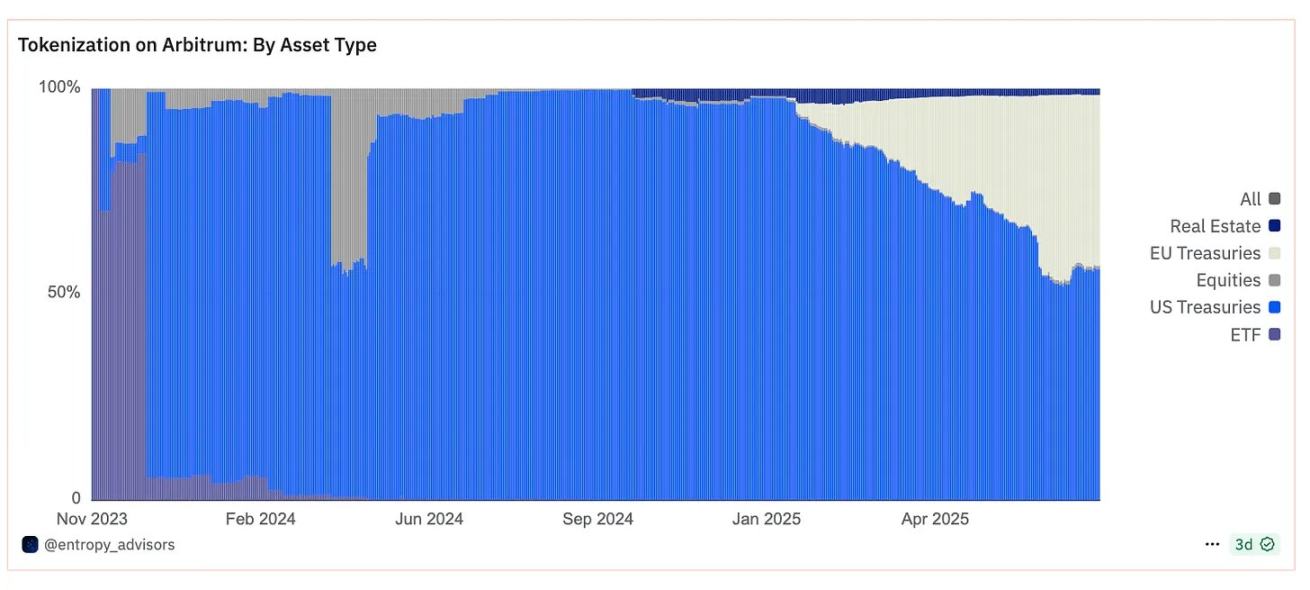
Although U.S. Treasuries still make up the majority of asset types ($197 million), EU Treasuries have followed closely behind ($150 million). Alternative assets such as real estate, stocks, and ETFs are also gaining traction.
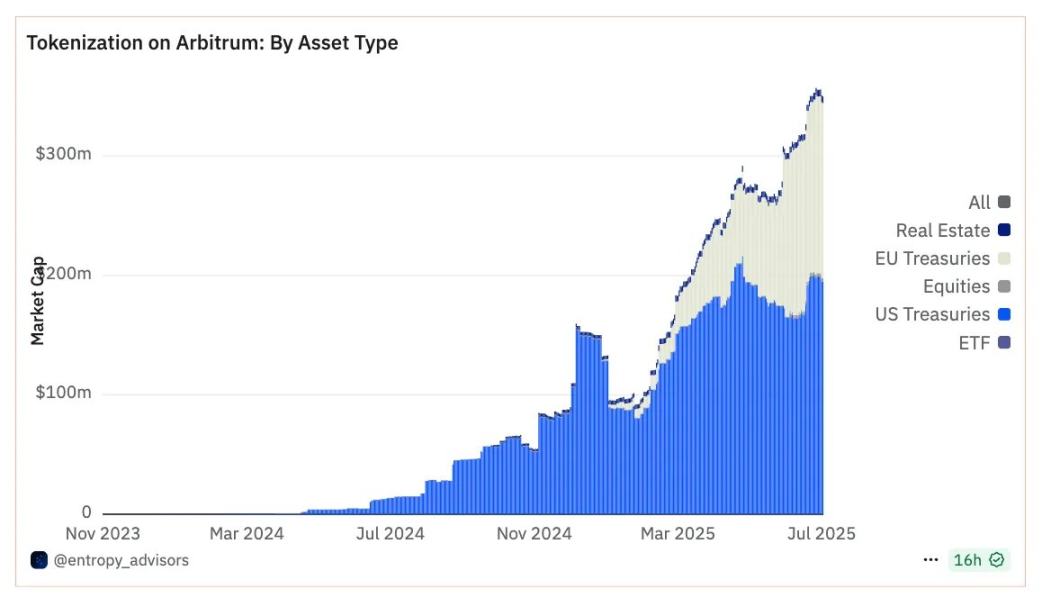
RWA Assets & Providers
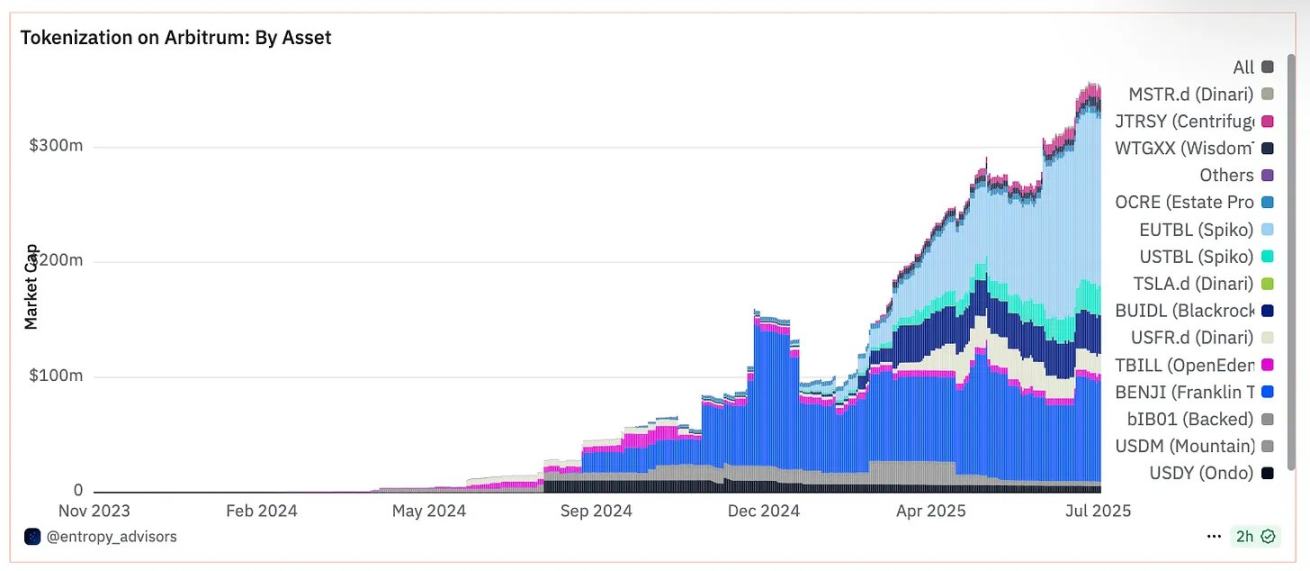
This section will delve into these asset classes, highlighting the top ten RWA products by total value, categorized by issuer.
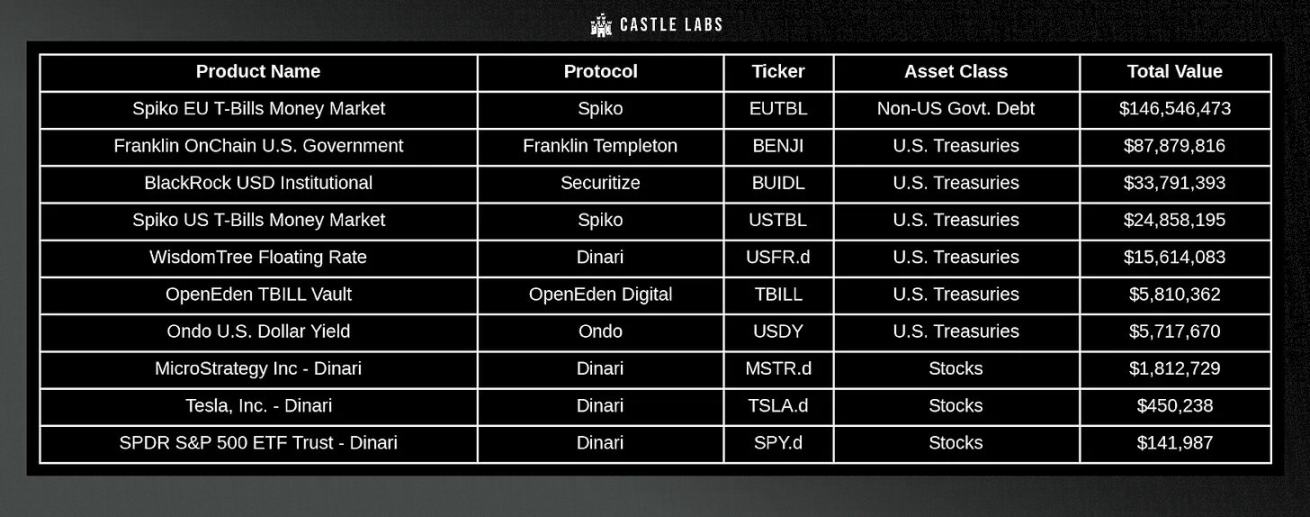
Spiko Spiko
has created an on-chain security token issuance and distribution platform.
The platform is licensed by the French Autorité des Munetsaires (AMF) to launch two money market funds:
-
Spiko Euro (EUTBL)
-
and Spiko USD (USTBL).
These funds are backed by a portfolio of short-term Treasury bonds with returns similar to the central bank's risk-free rate. Currently, they are among the most widely used, with EUTBL topping the list with a total value of $146 million and USTBL ranking fourth with $24.8 million, once again proving that short-term Treasury bonds are the most widely used assets on-chain.
Franklin Templeton
Franklin Templeton is a well-known investment management company listed on the New York Stock Exchange (BEN).
To bring tokenized mutual funds on-chain, the company launched the BENJI mobile app, which supports tokenized securities and cryptocurrencies with its proprietary system of record.
Each BENJI token represents a share of the U.S. Government Money Market Fund (FOBXX) on its Franklin chain. Currently, BENJI is the second-largest RWA product on Arbitrum, valued at over $87 million.
Securitize
Securitize is a platform that provides tokenized securities access services for institutional investors.
On Arbitrum, the platform offers BlackRock's USD institutional digital liquidity fund, BUIDL.
It is a short-term Treasury tokenization product focused on providing dollar yield on-chain, with a total value of over $33 million.
Dinari
Dinari allows the creation of tokenized stocks, ETFs, indices, etc., which are called "dShares" and maintain a 1:1 full endorsement relationship with the underlying asset.
Dinari has launched several products on Arbitrum:
-
WisdomTree Floating Rate Treasury Fund (USFR.d): Provides a low-cost access to U.S. government floating rate bonds, with a total value of over $15 million.
-
Tokenized MicroStrategy Stock (MSTR.d): $1.8 million.
-
Tokenized Tesla Stock (TSLA.d): Total value of $450,000.
-
Tokenized S&P 500 ETF Trust (SPY.d): An index of S&P 500 constituent companies with a size of approximately $141,000.
These assets highlight the potential of stocks and indices, but they still have a low representation in Arbitrum.
OpenEden
OpenEden provides access services for products such as tokenized U.S. securities. The platform is licensed by the Bermuda Monetary Authority, holds a digital asset operating license, and has a "investment grade" rating from Moody's.
Currently, the platform is the most important issuer of tokenized U.S. Treasury bonds in the European and Asian regions. OpenEden has launched a TBILL pool where users can invest in short-term U.S. Treasuries.
Currently, the pool has over $5.8 million in deposits.
Ondo
Ondo provides investors with access to institutional financial products.
On Arbitrum, its USDY product has initially received a positive response, currently with a total value of $5.7 million.
USDY is an interest-bearing stablecoin backed by U.S. Treasury bonds with an annualized yield of around 4.29%.
Despite Arbitrum's rich portfolio of products and assets, the RWA ecosystem is still in its infancy.
Its future development will depend on:
-
Asset expansion at the chain level to meet broader needs
-
Strategic focus on RWA as an area of strength for Arbitrum
-
Collaboration between Arbitrum Alliance Entities (AAEs) Institutional
-
push at the business development level
Future Outlook
Theinitial providers established in STEP 1 were supplemented with a new batch of providers during STEP 2, enriching the range of assets and products on Arbitrum.
Based on the current rate of growth of Arbitrum's total RWA value, we can make the following predictions:
-
Form a billion-dollar RWA ecosystem
-
Incorporate more asset classes (private credit, real estate, interest-bearing stablecoins, etc.)
-
Achieve deeper interoperability between these assets across networks
Despite some progress so far, Arbitrum still has significant room for growth if it wants to solidify its position in this segment. In fact, Arbitrum only ranks seventh in the network ranking of total value of RWA assets; As far as current data is concerned, its total RWA locked value (TVL) of $350 million accounts for only 1.39% of the total market capitalization of on-chain RWA assets, accounting for a negligible proportion.
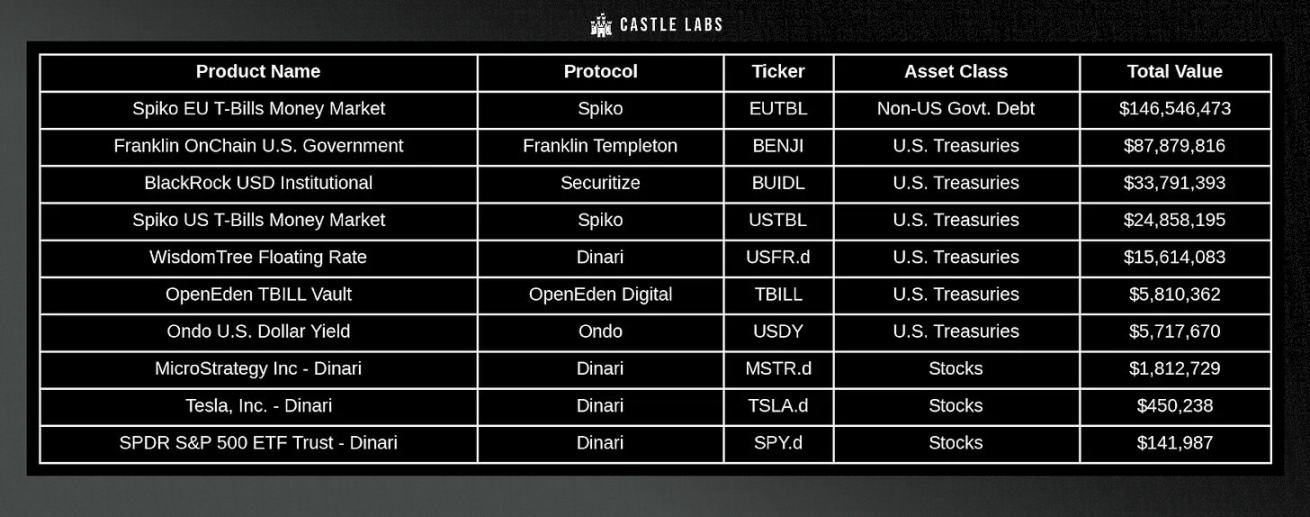
To compete with these networks, Arbitrum needs to explore more opportunities to expand into private credit issuance products, bonds, precious metals such as gold and silver, and stocks.
Given Entropy's deep involvement in treasury management and RWA-related matters on Arbitrum, we asked Matt for his thoughts on the future development of RWAs on Arbitrum. Here's what he said:
"Today, the core focus of many RWA issuers is to reduce the operating costs associated with issuance and transfer, and there is still a long way to go to validate this at scale. Nevertheless, the next big breakthrough for RWAs on Arbitrum will be a further boost in composability. It's not just about adding more asset classes or bringing in new issuers, it's just the first step. The real breakthrough lies in ensuring that these assets integrate with the more efficient on-chain foundations that the industry has built over the past decade: exchanges, lending protocols, index tools, pool optimization tools, and future innovations. Its ultimate goal is to achieve open, permissionless transferability, allowing RWAs to be freely composed like native crypto assets. We are not yet at this stage (a grandiose goal given the current regulatory reality), but this is our North Star. Encouragingly, industry giants like Franklin and WisdomTree have begun issuing tokens in person. This is true institutional level engagement and a trend that I would like to see continued growth. If we can make RWA-related user activities such as trading and lending actually happen on-chain – even if these activities are abstracted through permissioned channels based on Arbitrum – that will completely open up new ground."
We fully agree with Matt, especially regarding the composability and accessibility of these assets. Currently, the on-chain application potential of these assets is just emerging. We expect that in the near future, treasury bills, bonds, stocks, and commodities will not only be tokenized on-chain, but also integrated into various basic components in the current DeFi field.
From a methodological perspective, it is important to note that in this RWA-focused report, we did not include stablecoins in our analysis, as the core theme of the report is to highlight the various assets currently available on the Arbitrum platform.
Finally, it is also important to mention the relevant risks and precautions in the context of this analysis.
Risks and Forward-Looking Considerations
The-
disconnect between tokens and ecosystems: In reality, the growth of RWAs does not directly translate into value appreciation for ARB tokens.
-
Asset Concentration Risk: Short-term Treasuries still account for a very high proportion of RWA's total value locked (TVL), highlighting the need for diversification into multiple asset classes such as private credit, corporate bonds, and real estate.
-
Regulatory Dynamics Risks: While the regulatory landscape for cryptocurrencies is constantly improving and gradually moving towards legalization, the compliance framework for tokenized securities is still in the development stage, while institutional issuance requires higher regulatory clarity and cross-jurisdictional synergy.
The expansion of asset issuers, as well as the on-chain expansion of RWA categories such as private credit and real estate, is expected to drive the total value locked (TVL) of the Arbitrum ecosystem closer to $1 billion by the end of the year.
As the Treasury Management Plan and STEP 2 move forward, we expect to gain more information and insights that will not only further reveal the results of the plan, but also inform future decisions and initiatives.
Conclusion
Arbitrum's total value locked (TVL) of RWAs has grown from near zero to $350 million in just over a year.
The STEP program and a series of DAO-led initiatives have played a key role in driving early growth. In the process, a number of diversified institutional-grade products have been launched on Arbitrum, such as short-term Treasury bonds, money market funds, tokenized stocks, etc.
Thesuccessive entry of institutions such as Franklin Templeton and WisdomTree further solidifies Arbitrum's core position as a "reliable, neutral, and low-cost network" in the institutional-level DeFi space.
But the process is just getting started.
In addition to the risks and issues mentioned above, Arbitrum will face several strategic opportunities in the coming months.
This includes expanding RWA categories such as private credit, real estate, and commodities that are not yet fully covered, and more importantly, improving the composability of these new products and achieving deep integration with Arbitrum's core infrastructure components (decentralized exchanges, lending protocols, capital pools, etc.).
As the ongoing STEP 2 and treasury management initiatives continue to inject momentum and provide practical experience, the synergy between DAOs, alliance entities, and institutional participants will be key to Arbitrum's long-term leadership in the RWA space.
